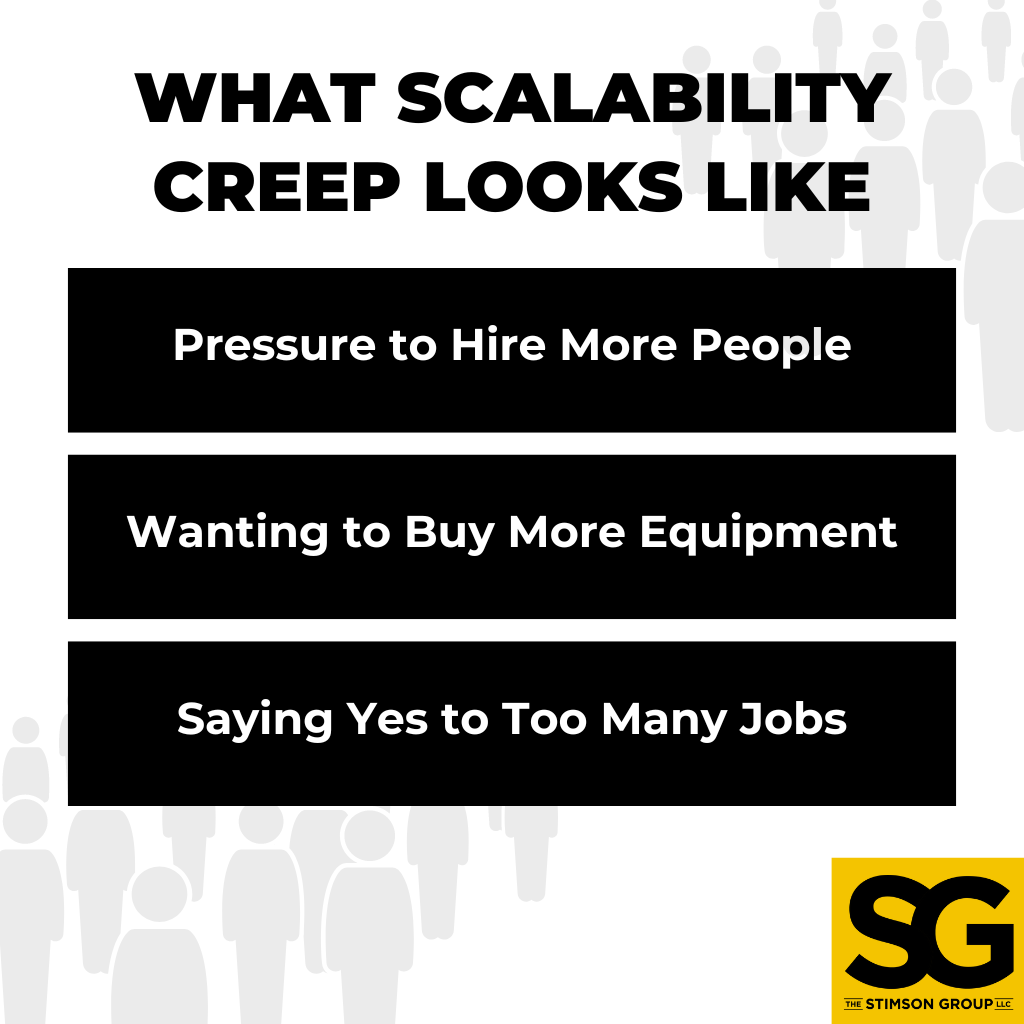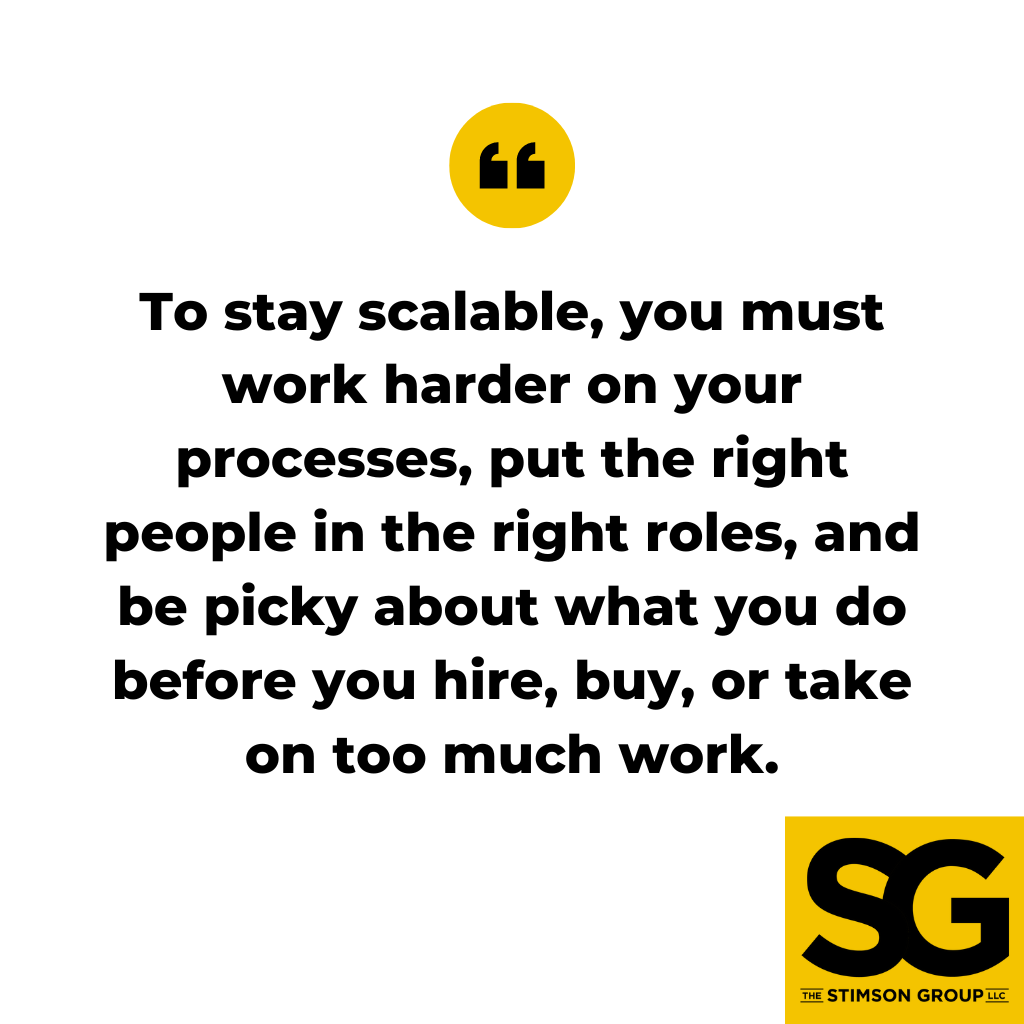
Listen instead on your Monday Morning Drive:
More and more of my clients tell me they’ve remained scalable post-pandemic. They’re proud of their scalability credentials, as am I.
However, those same business owners ask questions that suggest staying scalable long-term might be more difficult than getting there.
These owners suffer from scalability creep. Here’s how to identify it — and how to avoid it.

What Scalability Creep Looks Like
1. Pressure to Hire More People
Have your employees told you they need more people to do all the work you’ve assigned? Have they told you the way your business operates is unsustainable with your current staff size?
Usually, if you feel like you need to hire more people, it actually means you need to scale more efficiently. Ask yourself:
- “Can I balance my employees’ workloads better?”
- “Can I change my employees’ responsibilities?”
- “Can I improve my processes?”
In scalable companies, small changes are often all that’s needed to address a heavy workload. Hiring more people is a big change.
For instance, if the planning team says the sales team is selling the wrong kind of work, company leadership needs to investigate. Do you pursue the wrong clients? Do you schedule jobs at bad times or charge the wrong prices?
Any of these problems make the planning team unhappy, and they’re easy to address in a scalable model.
2. Wanting to Buy More Equipment
Does your planning team think they’re spending too much money sub-renting equipment?
It’s natural to want to buy more gear. It feels good to say, “We own this.” But scalable companies need to look at numbers, not just feelings.
Ask yourself:
- “Am I making the profit I should be?”
- “Do I own what I need for everyday work?”
- “Do I have to say no to jobs because I don’t have the gear?”
Not owning equipment isn’t an equipment problem. It’s a planning problem. You don’t need to own everything, as long as you have the right solution at the right time.
3. Saying Yes to Too Many Jobs
Taking on just one more job than you can handle is often tempting. But it’s important to have clear rules for saying no, especially for work that doesn’t fit your plan.
Before you became scalable, “This client has a ton of money, so we can figure it out” was the only reason you needed to take on one extra job. But sometimes, your best client needs you for a last-minute gig. That’s the one extra job to say yes to.
Don’t say yes to junk food. Save room for dessert. Be there to save the day for your best customer.
Scalability: The Great Balancing Act
When scalable companies face problems, they invest in better processes and information rather than buying more resources (people and equipment). If you believe hiring more people and buying more gear makes your operations easier, your processes are flawed.
Companies that hire people to fix process problems never had good processes to begin with. The key is adjusting roles and using your existing team’s strengths without throwing more bodies at challenges.
For example, when scalable companies have more business than their existing Project Management team can keep up with, they shouldn’t simply hire more project managers. Instead, they might redistribute some project management tasks to the Planning team so that individual PMs can handle more projects.
Avoiding Slowdowns
To avoid scalability creep, watch out for counter-statements from your team. Take note if they pressure you to hire more people, buy gear, or take one less job than you’ve planned for.
Maybe they get along with one freelance technician and want him to join the team. Maybe they say the gear you sub-rent is too cool not to own. These statements are valid, but don’t let them steer you off track.
When an employee alerts you to a problem, revisit scalability. How can you mitigate this issue while staying scalable instead of returning to your pre-scalability ways?
Sometimes, you will need to hire, buy, or stretch. But make those choices based on clear rules:
Rules for Adding a Project Manager
- The individual loves your company, speaks your language, knows their stuff, and is a pleasure to work with.
- You can recover at least two times their total compensation in revenue.
- Your planning team can use them strategically to train technicians, solidify relationships with key clients, or do something more valuable than filling a show position.
If a new hire only checks two of the three boxes, keep looking. Being “unable to find anyone else this good” isn’t a valid reason to hire someone.
Your planning team should always be on the lookout for great people. There’s nothing wrong with upgrading your team!
Rules for Buying Gear
- Your brand is built on innovative solutions, not innovative gear.
- The technology in question is strategically important and difficult to source, and you’ll lose business without it.
- You can demand a top margin because the risk is worth the reward.
A piece of gear needs to meet all three criteria. If you’re buying gear just because it’s easier to buy than rent, gear isn’t your issue. Look at your people and processes.
Rules for Taking Extra Jobs
To say yes to one more job than you can handle, it must:
- Fit your ideal customer profile
- Fit your ideal project profile
- Fall well-within your capabilities
Taking on one extra job isn’t just about making money. It’s about positioning yourself for future success. When a job meets all three criteria, you can do just that.
Final Thoughts
To stay scalable, you must work harder on your processes, put the right people in the right roles, and be picky about what you do before you hire, buy, or take on too much work.
When making those decisions, rely on clear rules to keep your scalability on track. Question the real problems.
Staying focused and following the rules keeps your business from reverting to old, unscalable habits. Stay the course — it’s worth it.






Leave a Reply